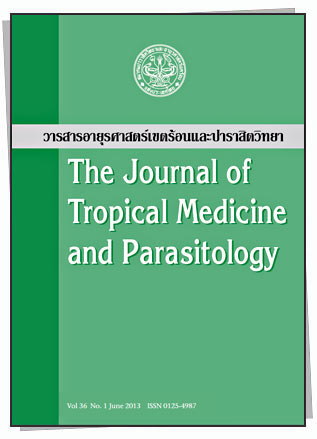Seasonal Variation of Opisthorchis viverrini Metacercarial Infection in Cyprinid Fish from Southern Cambodia
Main Article Content
Abstract
Abstract
Small liverfluke infections are caused by fish-borne trematodes, which remain the major causative agent of cholangiocarcinoma in the Greater Mekong Subregion. In this paper, we describe variations of metacercarial infection with Opisthorchis viverrini among cyprinid fish caught in endemic areas of southern Cambodia, during the period 2008-2009. One thousand, eight hundred and seventy-four fish (1,874), comprising 17 different species, were collected from 8 sites in Kandal Province. The pectoral fins, tail fins and muscles of the fish were examined by tissue-compression technique. Opisthorchid metacercariae were found among all species of fish tested, ranging from 5.6% (1/18) in Crossocheilus reticulates (Cambodian name – Trey Changwa Chunh Chuak) to 100% (10/10) in Amblyrhynchichthys truncates (Trey Kambot Chramos). The prevalence of Opisthorchis viverrini among fish in Kandal Province was 34.3% (642/1,874). The highest level of infection found was in fish caught from O’Roley Bridge, with a rate of 57.2% (214/374). Metacercariae appeared throughout the entire examination period – except for August 2009, when the area was dry and fish could not be caught – with different positive rates; the average and range were 34.3% and 2.0-76.2%, respectively. Numbers peaked in March and were lowest in July. The prevalence of O. viverrini metacercariae in fish was significantly (p < 0.05) negatively correlated with the water level in Lake 500, as recorded monthly during the study period.
Keywords: Opisthorchis viverrin; metacercaria; cyprinid fish;southern Cambodia; seasonal variation
